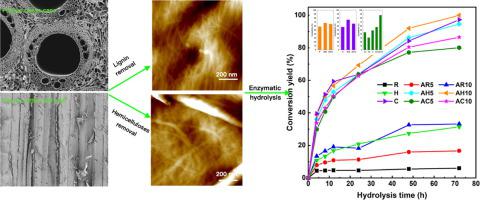Bioresource Technology ( IF 9.7 ) Pub Date : 2022-11-22 , DOI: 10.1016/j.biortech.2022.128381 Zhe Ling 1 , Jiajun Wang 2 , Jinyi Zhao 1 , Long Feng 2 , Jianfeng Ma 2 , Xinge Liu 2

|
Global energy concerns urged us to search for sufficient utilization of biomass to renewable energy. Herein, rattan biomass displaying herbaceous species-like anatomy and hardwood-like chemical composition was used as model of lignocellulose to determine its recalcitrance inhibiting efficient bioconversion. Delignification and continuous mild alkaline treatments were applied for deconstruction of rattan cane (Calamus simplicifolius) followed by cellulase enzymatic hydrolysis. Cellulose supramolecular structural variations were proved to be the major reason for the enhanced hydrolysis in addition to the removal of lignin and hemicelluloses matrix. Lowered crystallinity (50–65 %) as well as swelled crystallite sizes (4.8–5.0 nm) during allomorphic transformation favored the enhanced hydrolysis, rather than the crystalline cellulose II. Moreover, well-distributed separation and fibrillation of cellulose elementary fibrils also contributed to glucose yield promotion. The study will provide new insights to the strategy to efficient bioconversion of lignocellulosic biomass.
中文翻译:

深入了解影响藤生物质生物转化效率的关键因素:纤维素的超分子结构变化
全球能源问题促使我们寻找充分利用生物质的可再生能源。在此,显示草本物种样解剖结构和硬木样化学成分的藤生物质被用作木质纤维素模型,以确定其抑制有效生物转化的顽固性。脱木素和连续弱碱处理用于解构藤条(Calamus simplicifolius) 随后进行纤维素酶水解。除了去除木质素和半纤维素基质外,纤维素超分子结构变化被证明是增强水解的主要原因。在异质转变过程中,降低的结晶度 (50–65%) 以及膨胀的微晶尺寸 (4.8–5.0 nm) 有利于增强水解,而不是结晶纤维素 II。此外,纤维素基本原纤维的均匀分离和原纤化也有助于促进葡萄糖产量。该研究将为木质纤维素生物质的有效生物转化策略提供新的见解。











































 京公网安备 11010802027423号
京公网安备 11010802027423号